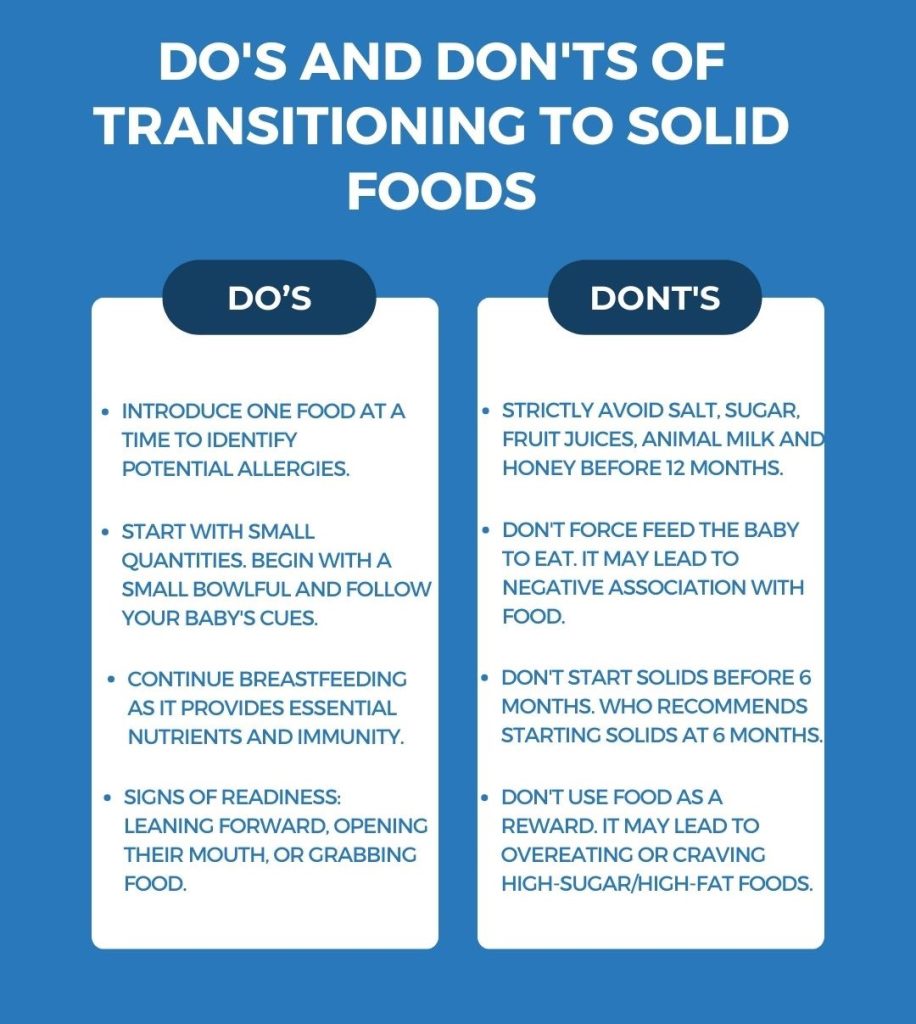Moving from only breast milk to eating solid foods is an exciting new chapter for your baby! But how do you know when it’s the right time? Around 6 months, babies start showing signs they are ready to begin solids — they can sit up, bring things to their mouths, and seem interested in the foods they see you eat.
As you introduce soft finger foods once or twice a day, remember that breast milk is still the most important source of nutrition. Aim to breastfeed on demand through your baby’s first year. This helps strengthen immunity, provides comfort, and supports growth, even as you introduce new foods.
The transition to adding solid foods is slow and gradual. You can continue breastfeeding your baby beyond 12 months. Moving at your baby’s pace allows them time to adapt while still enjoying the lifelong benefits of breastfeeding.
Importance of Breastfeeding From 6-12 Months
Breastfeeding is crucial even when you start solids because, until the age of 1, your child’s primary source of nutrition is breast milk. Although you may begin introducing solids around 6 months, these foods are only complementary to breastfeeding.
No solid food can replace breast milk in your child’s first year. When starting with one solid meal a day at around 6 months of age, continue offering breast milk on demand. Ideally, offer the solid meal first and then breastfeed if your baby shows hunger cues afterward. Avoid offering breast milk immediately after a baby rejects a meal, as this can create confusion about hunger and fullness.
Breast milk not only contains essential nutrients and easily digestible proteins but also provides antibodies that help protect your baby from infections. Additionally, breast milk is considered a living substance because it contains living cells, including immune cells and beneficial bacteria, which contribute to your baby’s health.
Benefits of Breastfeeding Beyond 12 Months
Many moms choose to continue nursing past the first birthday, and some even extend it until their babies are 2. Research shows breast milk remains loaded with value beyond infancy. Consider these benefits if you’re deciding between breast milk and solid foods:
Improved immunity – Breast milk provides live antibodies that help fight infections even in the second year, reducing respiratory and gastrointestinal illnesses.
Nutrition – This adapts as your toddler grows, delivering vitamins, protein, and healthy fats for needed energy. It’s especially important during picky eating phases.
Emotional comfort – Nursing offers warmth, nurturing contact, and relaxation when your little one gets distressed or hurt.
Convenience – Breastfeeding provides a quick, nourishing snack or soothes upset stomachs.
Oral health – Breast milk contains bacteria that support tooth and jaw development.
You need to let your baby enjoy more table foods and independence through toddlerhood.
How To Know Your Breastfed Baby Is Ready for Solid Foods
1. Baby Can Sit Up Without Support
When your little one can sit up straight without any help, it shows their muscles are growing stronger. Their neck and back can now hold up their head and body, which is important during feeding time.
Before solids, babies only had milk, so when you start rice cereals or mushy foods, they need to move bites from spoon to tummy without spills or choking. Sitting helps them swallow safely, as it means their neck and back coordination is developed. This helps them learn the motions needed for sampling and enjoying new foods.
2. Shows Interest in Food
Does your child reach out to get a bite from your plate or try grabbing your spoon? This food curiosity signals they are ready! Starting solids lets them explore new tastes and textures beyond milk. Around 6 months, you can introduce solids to supplement breast milk.
Watching you eat with interest shows they long to grow up and chow down. It kickstarts the journey to sharing family meals. Let their curiosity guide the timing (which is roughly around 6 months) as you consider introducing solids and breastfeeding at the same time.
3. Loss of Tongue Thrust Reflex
The tongue thrust reflex is an automatic pushing out of food from the mouth using the tongue. It is present in babies and helps with breastfeeding and swallowing milk. This reflex should fade as the baby transitions to solid foods. When this happens, they gain control of side-to-side tongue motions needed for eating solids. So when introducing purees or cereals, don’t worry about messes at first.
Your baby will slowly learn to perfect this tongue coordination. That’s why you need to continue introducing solids to babies, even when they are making a mess. It’s a learning process. You can chat with your pediatrician to know more about this process, as it’s essential for upgrading from breast milk to solid foods.
4. Increased Hunger Even After Breastfeeding
Do they wake at night eager to breastfeed despite full days of nursing? And does that nursing session fail to satisfy their hunger? This is a sign to start giving solids to your baby. Around 6 months, your baby needs both breastfeeding and solids.
Even if you offer the breast much more frequently, their tummy likely yearns for bigger and more nutrient-dense meals. You can speak to your pediatrician about your baby’s breastfeeding and solid schedules. You can give them pureed fruits/veggies, cereals, and finger foods to satisfy their hunger.
5. Reaches 6 Months of Age
Has your baby reached the 6-month mark? This signals it’s time to begin introducing solids along with your current breastfeeding schedule. Around 6 months, doctors agree a baby’s digestive system is mature enough to process both breastfeeding and solid food. The transition to solid foods meets growing nutritional needs after breastfeeding.
The World Health Organization encourages breastfeeding for up to 2 years and beyond. So mothers can start giving solids to their 6-month-old babies. Starting solids at 6 months provides extra nutrition as your baby’s diet expands.
First Solid Food for 6-Month-Olds
Around 6 months, you can begin offering your little one their first tastes of solid food along with breast milk. These first foods for babies provide key nutrients to supplement breast milk:
- Rice/ragi porridge
- Mashed rice and ghee
- Steamed and mashed veggies
- Rava upma
Start slowly with just a few spoonfuls at a time when introducing solid foods for 6-month-olds. Allow your baby to explore new textures and flavors at their own pace. You can download our Happy Eaters app to learn about breastfeeding and solids for your baby. We also have licensed pediatricians who can guide you during your baby’s baby-led weaning period.
Iron-Rich Solid Foods for Babies
Around 6 months, adding nutritious solid foods along with breast milk helps ensure your baby gets enough iron. You can give these iron-rich foods to your baby:
- Mashed moong dal khichdi
- Pureed spinach or leafy greens (saag)
- Ragi (finger millet) porridge
- Beetroot carrot mash
You need to introduce new foods slowly, starting with just a spoonful or two and paying attention to your baby’s cues on quantity. This will help you balance the breastfeeding and solid schedules for your baby. You can start giving more varieties of foods as they are essential for growth and nourishment.
Soft Finger Foods for Babies
When introducing solids to babies around 6 months, start with easily grasped foods that they can pick up and enjoy at their own pace as you supervise. Some of the best first finger foods are:
- Steamed idli (small, soft pieces)
- Cooked and mashed potato or sweet potato
- Soft pieces of chapati soaked in dal
- Steamed carrot, beetroot, cauliflower fingers
- Dosa strips (soft and easy to hold)
- Banana slices (ripe and mashed slightly for softness)
You must avoid whole grapes, bits of apple, popcorn, or other hard snacks at first. You can experiment to see which solid food for a 6-month-old baby is the best by offering one new food at a time and observing their reactions. Allow self-feeding without pressure to eat a certain amount.
The main thing is to supervise closely while allowing your baby to touch, feel, taste, and learn about these solid finger foods at their own speed. Avoid any foods that pose a choking risk for their age and stage.
Finding the right rhythm between nursing sessions and solid food intake comes with time and responsiveness. You can keep breast milk as the primary source of nutrition until they reach 12 months.
You can offer solids once or twice a day at first. As solids gradually increase into several small meals per day, maintain a nursing pattern based on your baby’s cues rather than sticking strictly to a breastfeeding and solid schedule. Remember, breast milk provides antibodies and easily digested calories that babies need in the first year as they grow rapidly.






